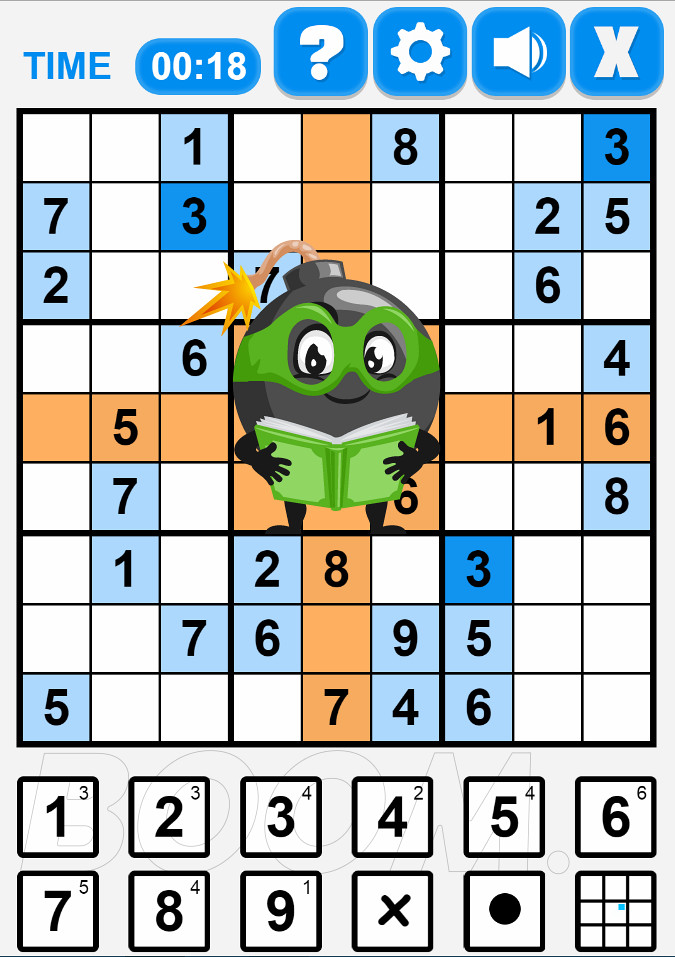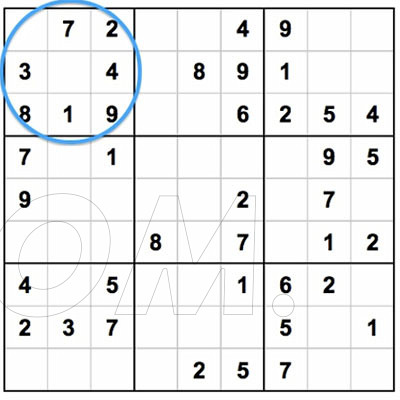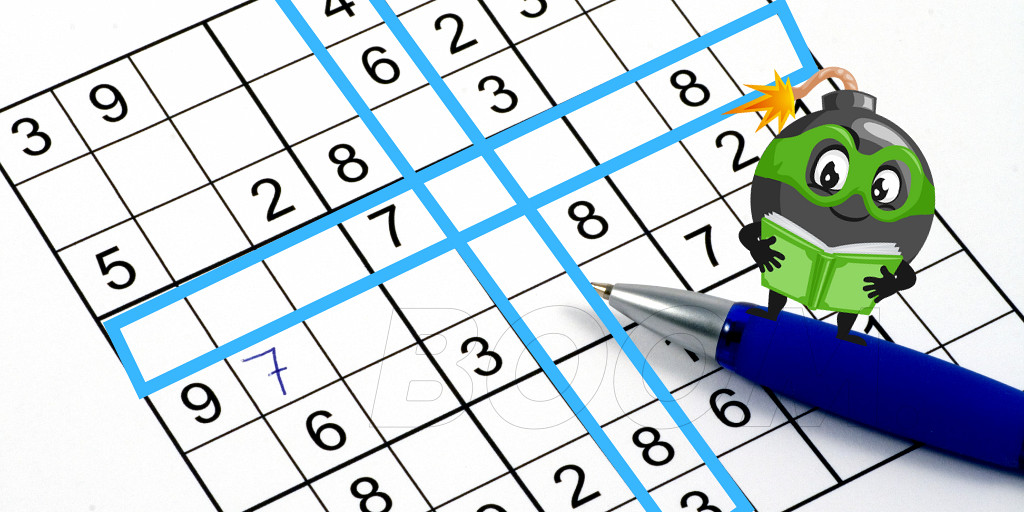Sudoku online - Free Game and Improve Your Brain at Explode Games

Free Sudoku Online - Good Brain Exercise!
Welcome to the world of Sudoku! This popular puzzle game has been a source of entertainment and mental exercise for people worldwide since it was first introduced in 1986 in Kyoto, Japan. We were immediately hooked when we discovered it during a visit to the city and have been playing it ever since.
Daily Sudoku solutions can help keep your mind sharp and youthful. Sudoku can be played online or on paper, sometimes through newspapers. Here at BOOM, we offer a range of free Sudoku puzzles and other board and card games that challenge the brain.
Don't hesitate to jump in and start solving today! If you're new to Sudoku puzzles or looking to improve your skills, you'll find a wealth of helpful information and strategies in our Sudoku section. You can even try the game for free and test what you've learned in the article.
Sudoku is an abbreviation of the Japanese expression "Sūji was Kyokushin ni kagura", - which means "each number is limited to a single presence." - You can read more about what they mean by that below.
If you are an experienced Sudoku player, you will have experienced being stuck in a game where you can't get on no matter what you do. This is frustrating and makes the game so good because once you have solved the sudoku puzzle, you will feel great.
As in online Mahjong, there are also online game strategies for Sudoku that can help you improve your game. Remember, practice makes perfect. No one becomes a Sudoku master overnight. It takes time and hours with the game.
How to play Sudoku (find each number)
Seeing their first Sudoku board can be confusing for most beginners, with some squares containing little numbers. However, don't be intimidated by the seemingly simple layout – it holds a lot of complexity and entertainment value. Just take your time, and you can solve the Sudoku puzzle.

How to play Free Online Sudoku? (Rules for beginners). Tablet and PC.
Sudoku is about filling in a 9×9 square system - 9 large squares with 9 smaller squares inside. These squares have a few numbers filled in beforehand (depending on the difficulty)
When you fill in a number in a square, both the square and the whole row/column the number is in must add up so that all numbers from 1-9 appear only once.
The Sudoku single row and column
The Sudoku rows and columns go through the game board, so you have to make 1-9 add up inside each 3×3 square and outside that square. So you have to think carefully in Online Sudoku because it can take a long time to figure out the solution, often, you are just about to solve the Sudoku, but then you find out that you have used your desired number twice and have to start again!
Different variants of the Online Sudoku game
There are many variations of Sudoku, ranging from the smaller and easier 6x6 cell board to the more giant and more challenging 25x25 cell board. It's a bit like Mahjong, where the board and cell size can impact the game's mathematical outcome.
Here at our site, we focus on the classic 9x9 variant of Sudoku, as it is one of the many Sudoku games you can play for free. This allows you to quickly try out the Sudoku tips and strategies we discuss, giving you a hands-on understanding of the game. So why wait? Start playing and improving your Sudoku skills today!
Determining the Difficulty of a Sudoku Puzzle: Factors and Technique
Sudoku is a mathematical game that puts your logic to the test. When the game starts, some of the empty fields are filled in. If only very few numbers are filled in, the difficulty level increases significantly as you have to think a lot to make the game work. You can rate a Sodoku game from 1-5, with 5 being the hardest, and the classic Sudoku game is rated at about 3.5 on this Sudoku scale.

Sudoku difficulty is determined by the number of provided clues. Play online without downloading.
Sudoku: A Fun and Effective Way to Exercise Your Brain
It's no secret that everyday routine can leave us feeling sluggish and uninspired, both physically and mentally. If our brains aren't challenged, they can become sluggish and decision-making less efficient. That's where Sudoku comes in. By providing mental exercise, Sudoku can help improve blood flow to the brain and enhance cognitive function.
I have experienced the benefits of Sudoku training firsthand. After playing the game, I noticed a difference in my mental clarity and focus. And I'm not alone – several scientific studies have also demonstrated the positive effects of Sudoku on mental performance. So why not try it and see the difference for yourself?"
Starting a New Sudoku Game: Tips and Tricks
Like in Mahjong, the beginning of a Sudoku game can be challenging, but it's also crucial to get it right as it will impact your progress throughout the game. With some numbers already filled in as part of the game, it can be tough to know where to place your first new numbers.
One helpful strategy is the exclusion method, eliminating the options that don't work and narrowing down the possible placements for a given number. Another helpful tool is to make Sudoku notes, which allow you to jot down potential placements and try out different options. With a bit of practice and these strategies in your toolkit, you'll be well on solving your first Sudoku puzzle!"
Learning Sudoku Online: Tips for Beginners
If you're feeling overwhelmed by the game, one strategy you can try is starting with the smallest possible area, a 3x3 grid. This allows you to practice identifying which numbers are missing without being distracted by the entire board. This can give you a better understanding of how Sudoku works.
One potential drawback of this approach is that as you fill in more 3x3 squares, you may need to go back and make adjustments to other squares to complete the puzzle. However, with practice, you'll get a feel for how the game works and tackle larger sections of the board confidently.
Can a Sudoku be solved without guessing?
Sudoku is different from games like minigames, where a proportion of the outcome is based on luck and chance - in Sudoku, there is one particular way to solve the puzzle, so only a novice will try to guess a solution. The correct way to solve the Sudoku is by using some methods from the Sudoku guide. Guessing too much could get in your way in the long run. It's always better to train your brain to 'scan' the rows and columns of 1-9 numbers - a bit like looking at your supermarket receipt, where we are all masters at spotting zero-point-five discrepancies.
 2 Player
2 Player Action
Action Adventure
Adventure Animal
Animal Arcade
Arcade Board Games
Board Games Bubble Shooter
Bubble Shooter Card Games
Card Games Christmas
Christmas Defense
Defense Dress-Up
Dress-Up Driving
Driving Fighting
Fighting Girls
Girls Halloween
Halloween Mahjong
Mahjong Management
Management Match-3
Match-3 Math
Math Minesweeper
Minesweeper Multiplayer
Multiplayer Puzzles
Puzzles Racing
Racing Shooting
Shooting Simulation
Simulation Skill
Skill Sports
Sports Strategy
Strategy Sudoku
Sudoku Dansk
Dansk
